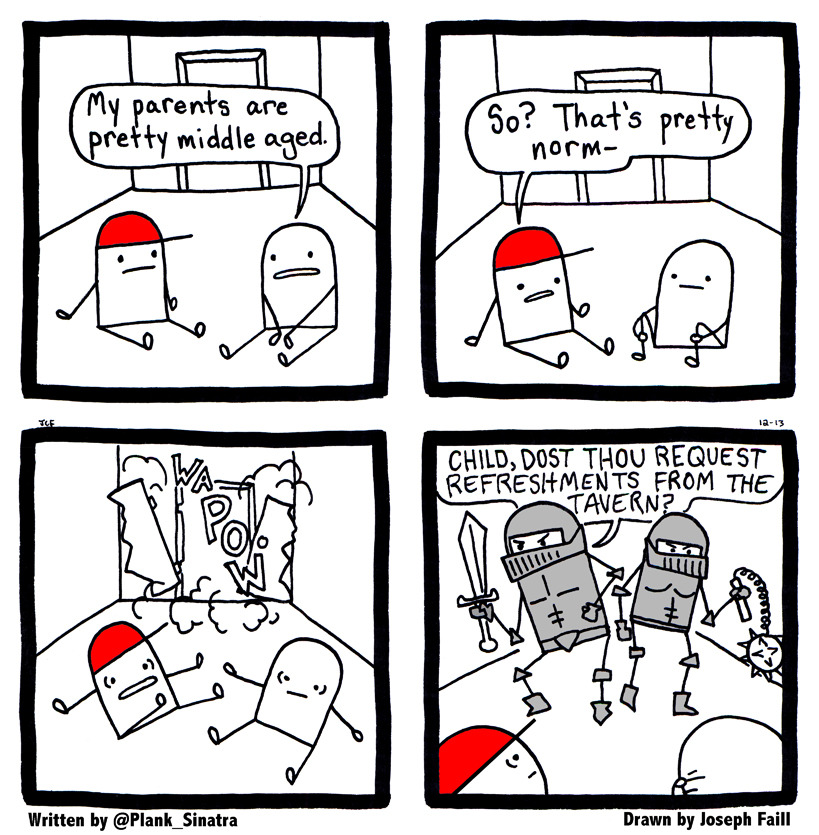Read the previous entry here!
The final episode in the series thought it might well be the last. And there is something in that.
2.10, "The One True King (to Unite Them All)"
Written by Rick Wiener, Kenny Schwartz, Luan Thomas, Julia Grob, and Joe Piarulli
Directed by John Fortenberry
Synopsis
 |
Some things seem not to change. Others very much do.
Image taken from the episode, used for commentary |
A young Richard and Gareth proceed among other children, playing and commanding applause from the others. The child-king realizes his incompetence and privilege and muses on his possible futures; the future Richard intrudes upon the musing, answering the youth's questions and falling into his own introspection.
Richard rouses from his reverie to find the besieged Hortensian forces looking askance at him in advance of the renewed zombie onslaught. A strange sound reaches them, though, as another force arrives--one which Madalena and Wormwood mark, as well. It is Sid, armed and leading the forces encountered in Galavant's previous adventures.
 |
Quite the striking image.
Image taken from the episode, used for commentary |
Sid forces his way through the undead army and reports on how he marshaled the army he brought to Galavant's aid in atonement for killing the knight. Galavant lays out a plan of attack, and battle is rejoined. Galavant and Gareth make themselves targets in the hopes of enabling a flanking maneuver on Madalena and Wormwood. Wormwood distracts Madalena so that he can more easily eliminate the two.
 |
I'm sure I've seen this struggle before...
Image taken from the episode, used for commentary |
Isabella comes across Madalena while she is distracted. And Richard confronts Wormwood. Fights break out among them. Wormwood informs Richard of his sword's purpose before disarming him; Richard attempts to invoke his "dragon" against Wormwood, to no avail. Wormwood attempts to retrieve Richard's sword, also to no avail, before the erstwhile king attacks him in cold rage, breaking the spells that turned and enhanced Galavant's army.
The fight between the two attracts the attention of the other focal characters, and they recognize him as the foretold king. Too, the "dragon" is, in fact, alive; Richard had thought him killed. Galavant congratulates him, and Richard charges him with the care of his "dragon" while he rushes off.
Gareth tries to reconcile with Madalena, but she refuses him in favor of greater power. Isabella retrieves the crown of Valencia and reconciles with Galavant; he proposes marriage to her, and she agrees
 |
She seems happy.
Image taken from the episode, used for commentary. |
Richard rides to reconnect with Roberta, who is about to embark for another land. He intercepts her in time to stop her, and they reconcile.
Galavant and Isabella wed. Gwynne and Vincenzo, having survived the battle, resume their lives. The Valencian monarchs are restored and their palace put to rights. Gareth and Sid go on a quest to retrieve Madalena--who commits herself to the study of dark magics. Richard and Roberta enjoy their lives together--with what is, in fact, a real dragon.
Discussion
At this point, with the series having ended years ago, now, not much else needs saying about it in the present context. More learned work that can afford to take more time and that has more access to resources than
an academic expatriate might well find more on which to comment, and in greater detail. Period dress, various social practices, deeper literary allusions could all take more bearing-out, certainly. And more "critical" criticism might happen, too, though I have tried in these short rewatch commentaries to ground what I say in what I have studied and what I know of the world in which I live. But I am as I am, trained as I am trained and farther away from that training than is perhaps comfortable for me to consider. I wonder if it is thus uncomfortable for others.
In any event, there is something that comes up at the end of the present episode, what ultimately is the end of the series as aired, that hearkens back meaningfully to the medieval (though to other sources, as well). In the Weird Al number near the end, in which he sings of the unlikelihood of another renewal for the series, there is something of the medieval
memento mori, the recognition that all things in this imperfect world end and die. It does not mean, of course, that there is no looking ahead to more and better--the song does motion towards possible third-season plots that are never realized, but there was an idea that more would come. There is some comfort in such thoughts, certainly for people living in the world we now recognize as being medieval, as well as for people living in the still-flawed world that allows for such follies and worse things as continue to beset it--too many of which continue to invoke the medieval badly and inaccurately in the service of horrible, terrible agendas that would do better to be stomped out than to be celebrated as they now too often are.
And there is more to come in this webspace, as well. The medieval continues to be used, not always badly if too often so, and how it is used continues to merit consideration. And even if so easily accessible an example as
Galavant is not immediately forthcoming, that does not mean there are not many to be found, or that the work of the Tales after Tolkien Society will not go on.









